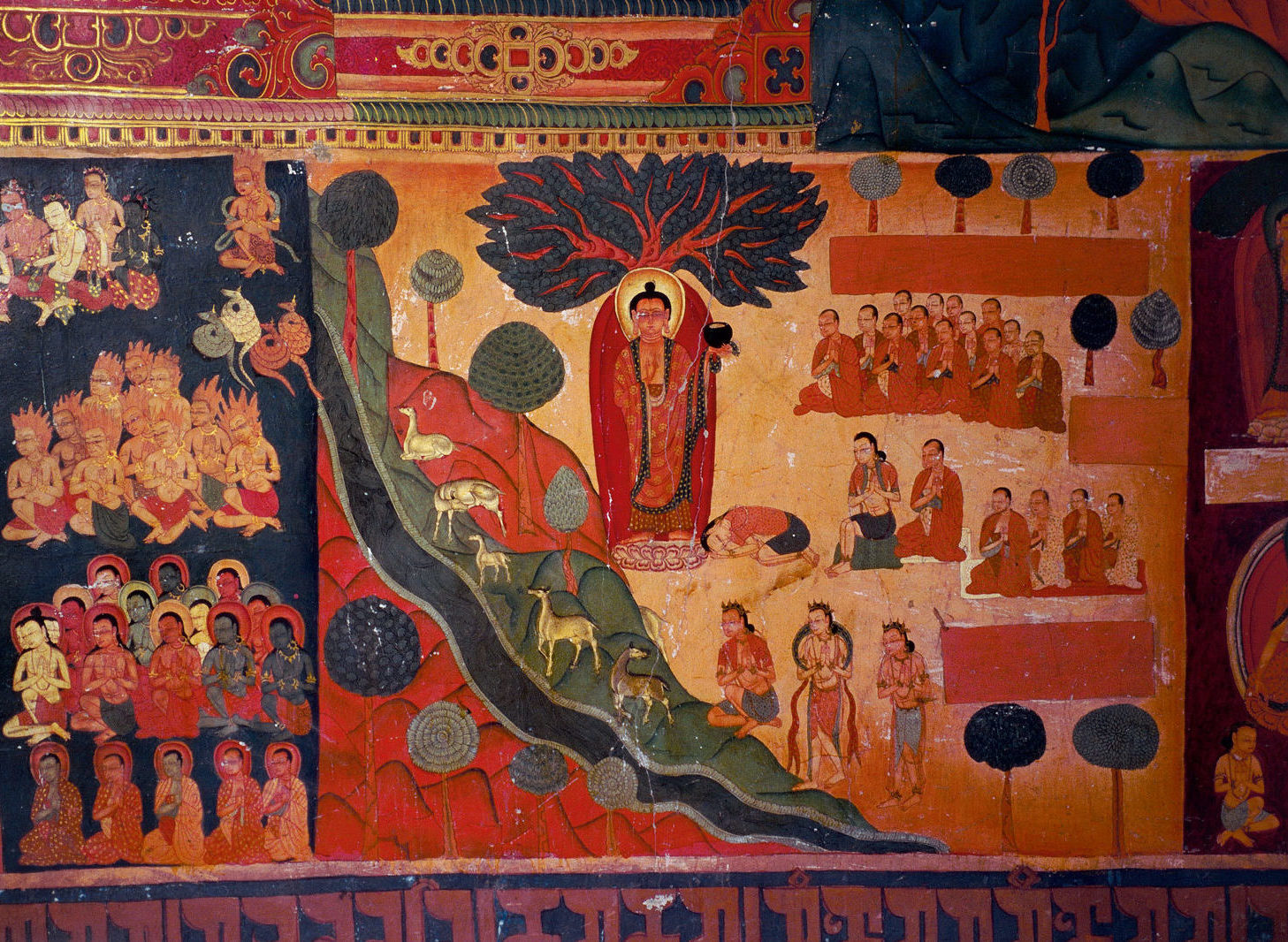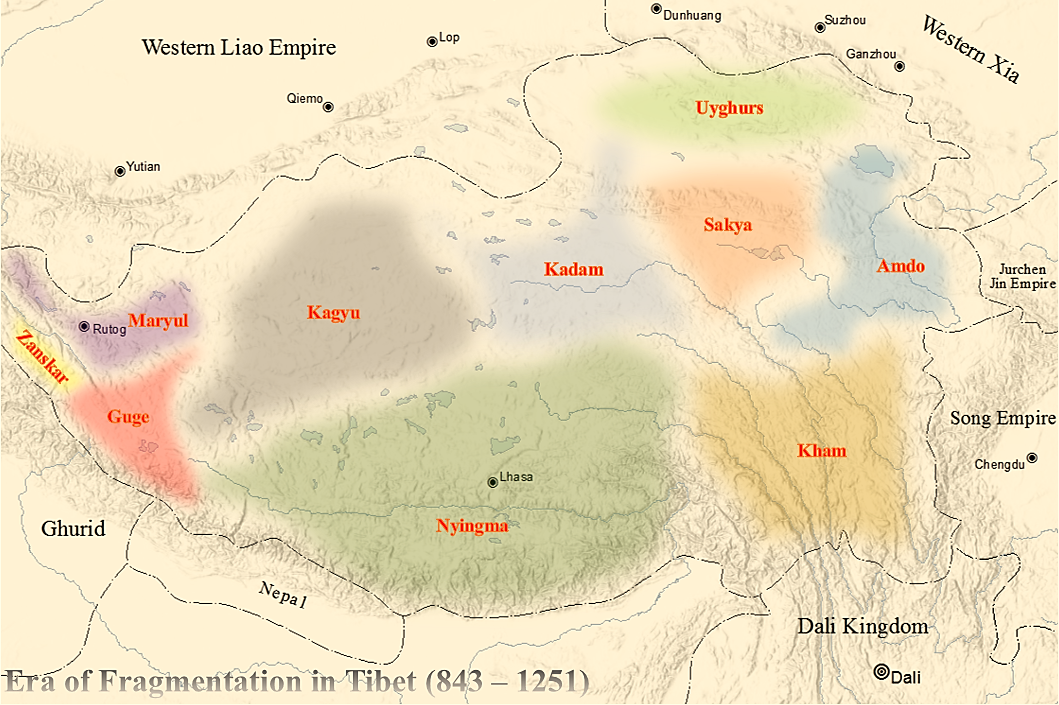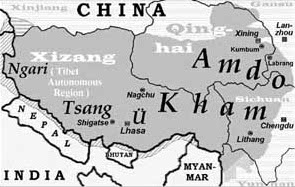|
Guge
Guge (; ) was an ancient dynastic kingdom in Western Tibet. The kingdom was centered in present-day Zanda County, Ngari Prefecture, Tibet Autonomous Region. At various points in history after the 10th century AD, the kingdom held sway over a vast area including south-eastern Zanskar, Upper Kinnaur district, and Spiti Valley, either by conquest or as tributaries. The ruins of the former capital of the Guge kingdom are located at Tsaparang in the Sutlej valley, not far from Mount Kailash and westwards from Lhasa. History Founding Guge was founded in the 10th century. Its capitals were located at Tholing and Tsaparang. Kyide Nyimagon, a great-grandson of Langdarma, the last monarch of the Tibetan Empire, fled from the insecure conditions in Ü-Tsang in 910 to arrive in Ngari (West Tibet). He established a kingdom around 912, annexing Purang and Guge. He established his capital in Guge. Nyimagon later divided his lands into three parts. The king's eldest son Palgyigo ... [...More Info...] [...Related Items...] OR: [Wikipedia] [Google] [Baidu] |
Tsaparang
Tsaparang was the capital of the ancient kingdom of Guge in the Garuda Valley, through which the upper Sutlej River flows, in Ngari Prefecture (Western Tibet) near the border of Ladakh. It is 278 km south-southwest of Shiquanhe, Senggezangbo Town and 26 km west of the 11th-century monastery at Tholing, and not far west of Mount Kailash and Lake Manasarovar. The Tsaparang Dzong architecture, Dzong was located here. Nearby is the Bon monastery of Gurugem monastery, Gurugem. Tsaparang is a huge fortress perched on a pyramid-shaped rock rising about 500 to 600 feet (152 to 183 m) at the end of a long narrow spur. It contains numerous tunnels and caves that have been carved out of the rock. At its base was a village where the common people lived. Above them were two public temples - the Lhakhang Marpo (Red Chapel) and the Lhakhang Karpo (White Chapel), and quarters for the monks. Further up, ascending a twisting stone staircase in a tunnel, were the royal quarters, and at the ... [...More Info...] [...Related Items...] OR: [Wikipedia] [Google] [Baidu] |
Maryul
Maryul (also called ''Mar-yul'' of ''mNgah-ris''), later the Kingdom of Ladakh, was a west Tibetan kingdom based in modern-day Ladakh and Tibet. The kingdom had its capital at Shey. The kingdom was founded by Lhachen Palgyigon, during the rule of his father Kyide Nyimagon, in .: "it seems that his father bequeathed him a theoretical right of sovereignty, but the actual conquest was effected by dPal-gyi-mgon himself." It stretched from the Zoji La at the border of Kashmir to Demchok in the southeast, and included Rudok and other areas presently in Tibet. The kingdom came under the control of the Namgyal dynasty in 1460, eventually acquiring the name "Ladakh", and lasted until 1842. In that year, the Dogra general Zorawar Singh, having conquered it, made it part of the would-be princely state of Jammu and Kashmir. Etymology ''Mar-yul'' has been interpreted in Tibetan sources as lowland (of Ngari),. Scholars suspect that it was a proper name that was in use earlier, even b ... [...More Info...] [...Related Items...] OR: [Wikipedia] [Google] [Baidu] |
Kyide Nyimagon
Kyide Nyimagon () (), whose original name was Khri-skyid-lding, was a member of the Yarlung dynasty of Tibet and a descendant of emperor Langdarma. He migrated to Western Tibet and founded the kingdom of Ngari Khorsum ("the three divisions of Ngari") around 912 CE. After his death, his large kingdom was divided among his three sons, giving rise to the three kingdoms of Maryul (Ladakh), Guge-Purang and Zanskar- Spiti. Family After the assassination of the emperor Langdarma, the Tibetan empire entered a period of civil war over succession by Langdarma's two sons (Yum-brtan) and ('Odsrung), which divided the empire into two parts. Ösung's son Depal Khortsen (–) is believed to have controlled most or part of Central Tibet. Nyimagon was one of the sons of Depal Khortsen, the other being Trashi Tsentsän (''bKraśis-brtsegs-brtsan''). Both the sons fled Ü-Tsang (Central Tibet) in 910 when their father was murdered, at the end of the 3rd , which is taken to mark the beg ... [...More Info...] [...Related Items...] OR: [Wikipedia] [Google] [Baidu] |
Tholing
Tholing (, literally "high place";), Toling, Tuolin, or Toding, alternatively Zanda, Tsanda, Tsada, or Zada, is a town and seat of Zanda County, Ngari Prefecture, in the west of Tibet Autonomous Region, People's Republic of China. The town was the former capital of Guge Kingdom in western Tibet when it was ruled by Langdarma. Now an isolated military town, it has a well laid out new street, a post office, and telecommunication facilities. The Tholing Monastery, established in 997 AD, is in the suburbs of the town, in the Grand canyon of the Langchen Tsangpo ( Sutlej River). Historically, this was an important monastery; the second dissemination of Buddhism in Tibet emanated from it. History Zanda is a Chinese name given to the ancient town known as Tholing, which was once the capital of the Ngari district in western Tibet. The town, the monastery, and Tsaparang, a rocky range with forts, played an important role the history of Tibetan Buddhism in west Tibet. Tholing and Tsapar ... [...More Info...] [...Related Items...] OR: [Wikipedia] [Google] [Baidu] |
Burang County
Purang County or Burang County (; ) is an administrative division of Ngari Prefecture in the Tibet Autonomous Region (''TAR'') of China. The county seat is Purang Town, known as ''Taklakot'' in Nepali. The county covers an area of , and has a population of 9,657 as of 2010. Geography Political geography Purang County has TAR's south-western border with Nepal's Sudurpashchim and Karnali province, Darchula, Bajhang and Humla District. Further west, India's Uttarakhand State, Pithoragarh district and Chamoli district borders. Buddhist, Hindu and Jain pilgrims going to Lake Manasarovar and Mount Kailash enter from Nepal via Simikot, and from India via Dharchula. The county is bounded by other counties in the Ngari Prefecture, including Zanda to the west, Gar to the northwest and Gê'gyai to the north. To the east is Zhongba County of Shigatse Prefecture. Physical geography The county covers an area of , and has a population of some 9,058 people as of 2010. The county s ... [...More Info...] [...Related Items...] OR: [Wikipedia] [Google] [Baidu] |
Tibet
Tibet (; ''Böd''; ) is a region in East Asia, covering much of the Tibetan Plateau and spanning about . It is the traditional homeland of the Tibetan people. Also resident on the plateau are some other ethnic groups such as Monpa, Tamang, Qiang, Sherpa and Lhoba peoples and now also considerable numbers of Han Chinese and Hui settlers. Since 1951, the entire plateau has been under the administration of the People's Republic of China, a major portion in the Tibet Autonomous Region, and other portions in the Qinghai and Sichuan provinces. Tibet is the highest region on Earth, with an average elevation of . Located in the Himalayas, the highest elevation in Tibet is Mount Everest, Earth's highest mountain, rising 8,848.86 m (29,032 ft) above sea level. The Tibetan Empire emerged in the 7th century. At its height in the 9th century, the Tibetan Empire extended far beyond the Tibetan Plateau, from Central Asian's Tarim Basin and the Pamirs in the west to Yunnan ... [...More Info...] [...Related Items...] OR: [Wikipedia] [Google] [Baidu] |
Zanda County
__NOTOC__ Zanda County () or Tsamda County () is a county in the Ngari Prefecture to the extreme west of the Tibet Autonomous Region of China. Its seat of power is at Tholing, the former capital of the Guge kingdom. Zanda or Tsamda is said to mean “a place where there is grass downstream”, an allusion to the grassy river bed of the Sutlej river that flows through the county. Ancient Zanda Horse (Hipparion zandaense) skeletons have been found in the Zanda County's Sutlej basin. horsetalk.co.nz, 25 April 2012. The Zanda County is bounded by India's state t ... [...More Info...] [...Related Items...] OR: [Wikipedia] [Google] [Baidu] |
Ngari Prefecture
Ngari Prefecture () or Ali Prefecture () is a prefecture of China's Tibet Autonomous Region covering Western Tibet, whose traditional name is Ngari Khorsum. Its administrative centre and largest settlement is the town of Shiquanhe. History Ngari was once the heart of the ancient kingdom of Guge. Later Ngari, along with Ü and Tsang, composed Ü-Tsang, one of the traditional provinces of Tibet, the others being Amdo and Kham. The lowlands of Ngari is known as Maryul. During the 10th century, the kingdom of Maryul was founded, taking the name Ladakh, lasted until 1842. The prefecture has close cultural links with Kinnaur and Lahaul and Spiti district of the bordering Indian state of Himachal Pradesh. Geography and climate The paved Xinjiang-Tibet Highway () passes through this area. There are well-known prehistoric petroglyphs near the far western town of Rutog. The town of Ngari lies above sea level in northwest Tibet some west of the capital, Lhasa. Ngari Gunsa Ai ... [...More Info...] [...Related Items...] OR: [Wikipedia] [Google] [Baidu] |
Ü-Tsang
Ü-Tsang is one of the three traditional provinces of Tibet, the others being Amdo in the north-east, and Kham in the east. Ngari (including former Guge kingdom) in the north-west was incorporated into Ü-Tsang. Geographically Ü-Tsang covered the south-central of the Tibetan cultural area, including the Brahmaputra River watershed. The western districts surrounding and extending past Mount Kailash are included in Ngari, and much of the vast Changtang plateau to the north. The Himalayas defined Ü-Tsang's southern border. The present Tibet Autonomous Region corresponds approximately to what was ancient Ü-Tsang and western Kham. Ü-Tsang was formed by the merging of two earlier power centers: Ü () in central Tibet, controlled by the Gelug lineage of Tibetan Buddhism under the early Dalai Lamas, and Tsang () which extended from Gyantse to points west, controlled by the rival Sakya lineage. Military victories by the powerful Khoshut Mongol Güshi Khan that backed 5th Dalai L ... [...More Info...] [...Related Items...] OR: [Wikipedia] [Google] [Baidu] |
Tibetan Empire
The Tibetan Empire (, ; ) was an empire centered on the Tibetan Plateau, formed as a result of imperial expansion under the Yarlung dynasty heralded by its 33rd king, Songtsen Gampo, in the 7th century. The empire further expanded under the 38th king, Trisong Detsen. The 821–823 treaty concluded between the Tibetan Empire and the Tang dynasty delineated the former as being in possession of an area larger than the Tibetan Plateau, stretching east to Chang'an, west beyond modern Afghanistan, and south into modern India and the Bay of Bengal. The Yarlung dynasty was founded in 127 BC in the Yarlung Valley. The Yarlung capital was moved to Lhasa by the 33rd king Songsten Gampo, and into the Red Fort during the imperial period which continued to the 9th century. The beginning of the imperial period is marked in the reign of the 33rd king of the Yarlung dynasty, Songtsen Gampo. The power of Tibet's military empire gradually increased over a diverse terrain. During the reign of T ... [...More Info...] [...Related Items...] OR: [Wikipedia] [Google] [Baidu] |
Langdarma
Darma Udumtsen (), better known by his nickname Langdarma (, "Mature Bull" or "Dharma the Bull") was most likely the last Tibetan Emperor who most likely reigned from 838 to 841 CE. Early sources call him Tri Darma "King Dharma". His domain extended beyond Tibet to include Dunhuang and neighbouring Chinese regions.Samten Karmay ''in'' , pg. 57 By tradition Langdarma is held to have been anti-Buddhist and a follower of Bon. He is attributed with the assassination of his brother, King Ralpacan, in 838 AD and he is generally held to have persecuted Buddhists. According to traditional accounts, during the first two years of his rule, Langdarma remained a Buddhist, but under the influence of Wégyel Toré (), he became a follower of Bon. Following his persecution of Buddhism Atiśa was called from Sumatra to restore Buddhism to Tibet. The anti-Buddhist portrayal of this king has been questioned by several historians, most prominently Zuiho Yamaguchi. Yamaguchi, Zuiho. “The ... [...More Info...] [...Related Items...] OR: [Wikipedia] [Google] [Baidu] |
Zanskar
Zanskar, Zahar (locally) or Zangskar, is a tehsil of Kargil district, in the Indian union territory of Ladakh. The administrative centre is Padum (former Capital of Zanskar). Zanskar, together with the neighboring region of Ladakh, was briefly a part of the kingdom of Guge in Western Tibet. Zanskar lies 250 km south of Kargil town on NH301. The Zanskar Range is a mountain range in the union territory of Ladakh that separates the Zanskar valley from Indus valley at Leh. Geologically, the Zanskar Range is part of the Tethys Himalaya, an approximately 100-km-wide synclinorium formed by strongly folded and imbricated, weakly metamorphosed sedimentary series. The average height of the Zanskar Range is about 6,000 m (19,700 ft). Its eastern part is known as Rupshu. The Zanskar had a population of approximately 20,000 in 2020. There has been demands to convert Zanskar into a district. Etymology Zanskar ( ''zangs dkar'') appears as ''“Zangskar”'' mostly in a ... [...More Info...] [...Related Items...] OR: [Wikipedia] [Google] [Baidu] |









